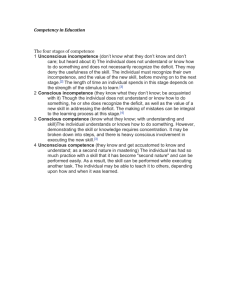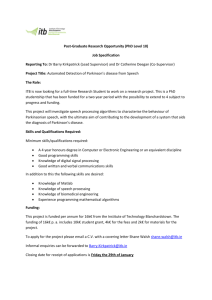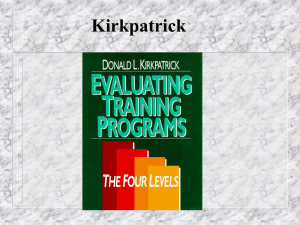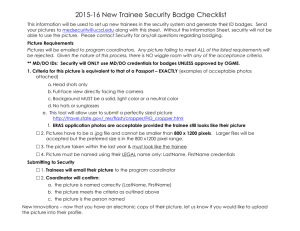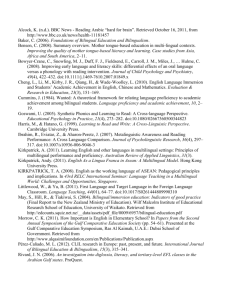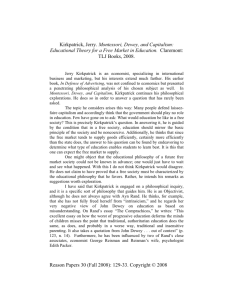Kirkpatrick Evaluation Model Paper ( DOC 50k)
advertisement
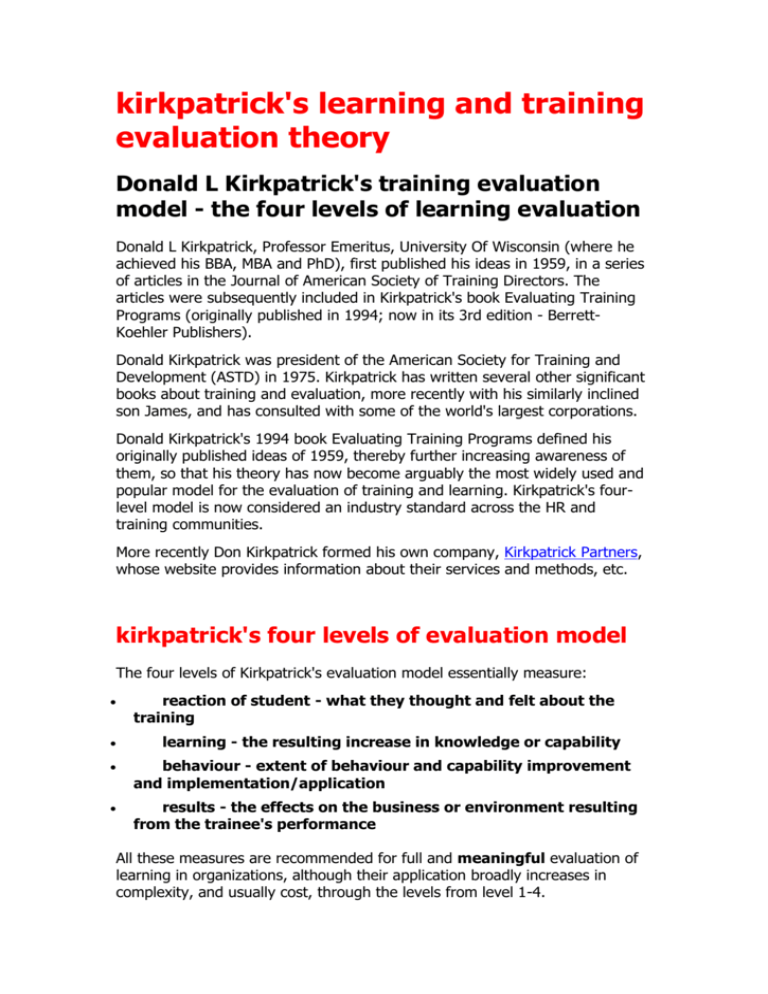
kirkpatrick's learning and training evaluation theory Donald L Kirkpatrick's training evaluation model - the four levels of learning evaluation Donald L Kirkpatrick, Professor Emeritus, University Of Wisconsin (where he achieved his BBA, MBA and PhD), first published his ideas in 1959, in a series of articles in the Journal of American Society of Training Directors. The articles were subsequently included in Kirkpatrick's book Evaluating Training Programs (originally published in 1994; now in its 3rd edition - BerrettKoehler Publishers). Donald Kirkpatrick was president of the American Society for Training and Development (ASTD) in 1975. Kirkpatrick has written several other significant books about training and evaluation, more recently with his similarly inclined son James, and has consulted with some of the world's largest corporations. Donald Kirkpatrick's 1994 book Evaluating Training Programs defined his originally published ideas of 1959, thereby further increasing awareness of them, so that his theory has now become arguably the most widely used and popular model for the evaluation of training and learning. Kirkpatrick's fourlevel model is now considered an industry standard across the HR and training communities. More recently Don Kirkpatrick formed his own company, Kirkpatrick Partners, whose website provides information about their services and methods, etc. kirkpatrick's four levels of evaluation model The four levels of Kirkpatrick's evaluation model essentially measure: reaction of student - what they thought and felt about the training learning - the resulting increase in knowledge or capability behaviour - extent of behaviour and capability improvement and implementation/application results - the effects on the business or environment resulting from the trainee's performance All these measures are recommended for full and meaningful evaluation of learning in organizations, although their application broadly increases in complexity, and usually cost, through the levels from level 1-4. Quick Training Evaluation and Feedback Form, based on Kirkpatrick's Learning Evaluation Model - (Excel file) kirkpatrick's four levels of training evaluation This grid illustrates the basic Kirkpatrick structure at a glance. The second grid, beneath this one, is the same thing with more detail. level evaluation evaluation type description and (what is characteristics measured) examples of evaluation tools and methods relevance and practicability 1 Reaction evaluation is how the delegates felt about the training or learning experience. 'Happy sheets', feedback forms. Quick and very easy to obtain. Verbal reaction, post-training surveys or questionnaires. Not expensive to gather or to analyse. Learning evaluation is the measurement of the increase in knowledge - before and after. Typically assessments or tests before and after the training. Relatively simple to set up; clear-cut for quantifiable skills. 2 Reaction Learning Interview or observation can also be used. Less easy for complex learning. 3 Behaviour Behaviour evaluation is the extent of applied learning back on the job implementation. Observation and interview over time are required to assess change, relevance of change, and sustainability of change. Measurement of behaviour change typically requires cooperation and skill of line-managers. 4 Results Results evaluation is the effect on the business or environment by the trainee. Measures are already in place via normal management systems and reporting - the challenge is to relate to the trainee. Individually not difficult; unlike whole organisation. Process must attribute clear accountabilities. kirkpatrick's four levels of training evaluation in detail This grid illustrates the Kirkpatrick's structure detail, and particularly the modern-day interpretation of the Kirkpatrick learning evaluation model, usage, implications, and examples of tools and methods. This diagram is the same format as the one above but with more detail and explanation: evaluation level and type evaluation description and characteristics examples of evaluation tools and methods relevance and practicability 1. Reaction Reaction evaluation is how the delegates felt, and their personal reactions to the training or learning experience, for example: Typically 'happy sheets'. Can be done immediately the training ends. Did the trainees like and enjoy the training? Did they consider the training relevant? Was it a good use of their time? Did they like the venue, the style, timing, domestics, etc? Feedback forms based on subjective personal reaction to the training experience. Verbal reaction which can be noted and analysed. Post-training surveys or questionnaires. Online evaluation or grading by delegates. Subsequent verbal or written reports given by delegates to managers back at their jobs. Level of participation. Ease and comfort of experience. Very easy to obtain reaction feedback Feedback is not expensive to gather or to analyse for groups. Important to know that people were not upset or disappointed. Important that people give a positive impression when relating their experience to others who might be deciding whether to experience same. Level of effort required to make the most of the learning. Perceived practicability and potential for applying the learning. 2. Learning Learning evaluation is the measurement of the increase in knowledge or intellectual capability from before to after the Typically assessments or tests before and after the training. Interview or observation can be used before and Relatively simple to set up, but more investment and thought required than reaction evaluation. learning experience: Did the trainees learn what what intended to be taught? Did the trainee experience what was intended for them to experience? What is the extent of advancement or change in the trainees after the training, in the direction or area that was intended? after although this is timeconsuming and can be inconsistent. Methods of assessment need to be closely related to the aims of the learning. Measurement and analysis is possible and easy on a group scale. Reliable, clear scoring and measurements need to be established, so as to limit the risk of inconsistent assessment. Hard-copy, electronic, online or interview style assessments are all possible. 3. Behaviour Behaviour evaluation is the extent to which the trainees applied the learning and changed their behaviour, and this can be immediately and several months after the training, depending on the situation: Did the trainees put their learning into effect when back on the job? Were the relevant skills and knowledge used Was there noticeable and measurable change in the activity and performance of the trainees when back in their roles? Was the change in behaviour and new level of knowledge sustained? Would the trainee be able to transfer their learning to another person? Observation and interview over time are required to assess change, relevance of change, and sustainability of change. Arbitrary snapshot assessments are not reliable because people change in different ways at different times. Assessments need to be subtle and ongoing, and then transferred to a suitable analysis tool. Assessments need to be designed to reduce subjective judgement of the observer or interviewer, which is a variable factor that can affect reliability and consistency of measurements. The opinion of the trainee, which is a relevant indicator, is also subjective and unreliable, and so needs to be measured in a consistent Highly relevant and clear-cut for certain training such as quantifiable or technical skills. Less easy for more complex learning such as attitudinal development, which is famously difficult to assess. Cost escalates if systems are poorly designed, which increases work required to measure and analyse. Measurement of behaviour change is less easy to quantify and interpret than reaction and learning evaluation. Simple quick response systems unlikely to be adequate. Cooperation and skill of observers, typically line-managers, are important factors, and difficult to control. Management and analysis of ongoing subtle assessments are difficult, and virtually impossible without a well-designed system from the beginning. Evaluation of implementation and application is an extremely important assessment - there is little point in a good reaction and good increase in capability if Is the trainee aware of their change in behaviour, knowledge, skill level? defined way. 360-degree feedback is useful method and need not be used before training, because respondents can make a judgement as to change after training, and this can be analysed for groups of respondents and trainees. Assessments can be designed around relevant performance scenarios, and specific key performance indicators or criteria. nothing changes back in the job, therefore evaluation in this area is vital, albeit challenging. Behaviour change evaluation is possible given good support and involvement from line managers or trainees, so it is helpful to involve them from the start, and to identify benefits for them, which links to the level 4 evaluation below. Online and electronic assessments are more difficult to incorporate assessments tend to be more successful when integrated within existing management and coaching protocols. Self-assessment can be useful, using carefully designed criteria and measurements. 4. Results Results evaluation is the effect on the business or environment resulting from the improved performance of the trainee - it is the acid test. It is possible that many of these measures are already in place via normal management systems and reporting. The challenge is to identify which and how relate to to the trainee's Measures would typically input and influence. be business or Therefore it is important organisational key to identify and agree performance indicators, accountability and such as: relevance with the trainee Volumes, values, at the start of the training, percentages, timescales, so they understand what return on investment, is to be measured. and other quantifiable aspects of organisational This process overlays normal good management performance, for practice - it simply needs instance; numbers of linking to the training complaints, staff turnover, attrition, Individually, results evaluation is not particularly difficult; across an entire organisation it becomes very much more challenging, not least because of the reliance on linemanagement, and the frequency and scale of changing structures, responsibilities and roles, which complicates the process of attributing clear accountability. Also, external factors greatly affect organisational and business performance, which cloud the true failures, wastage, noncompliance, quality ratings, achievement of standards and accreditations, growth, retention, etc. input. Failure to link to training input type and timing will greatly reduce the ease by which results can be attributed to the training. cause of good or poor results. For senior people particularly, annual appraisals and ongoing agreement of key business objectives are integral to measuring business results derived from training. Since Kirkpatrick established his original model, other theorists (for example Jack Phillips), and indeed Kirkpatrick himself, have referred to a possible fifth level, namely ROI (Return On Investment). In my view ROI can easily be included in Kirkpatrick's original fourth level 'Results'. The inclusion and relevance of a fifth level is therefore arguably only relevant if the assessment of Return On Investment might otherwise be ignored or forgotten when referring simply to the 'Results' level. Learning evaluation is a widely researched area. This is understandable since the subject is fundamental to the existence and performance of education around the world, not least universities, which of course contain most of the researchers and writers. While Kirkpatrick's model is not the only one of its type, for most industrial and commercial applications it suffices; indeed most organisations would be absolutely thrilled if their training and learning evaluation, and thereby their ongoing people-development, were planned and managed according to Kirkpatrick's model. For reference, should you be keen to look at more ideas, there are many to choose from... Jack Phillips' Five Level ROI Model Daniel Stufflebeam's CIPP Model (Context, Input, Process, Product) Robert Stake's Responsive Evaluation Model Robert Stake's Congruence-Contingency Model Kaufman's Five Levels of Evaluation CIRO (Context, Input, Reaction, Outcome) PERT (Program Evaluation and Review Technique) Alkins' UCLA Model Michael Scriven's Goal-Free Evaluation Approach Provus's Discrepancy Model Eisner's Connoisseurship Evaluation Models Illuminative Evaluation Model Portraiture Model and also the American Evaluation Association Also look at Leslie Rae's excellent Training Evaluation and tools available on this site, which, given Leslie's experience and knowledge, will save you the job of researching and designing your own tools.
